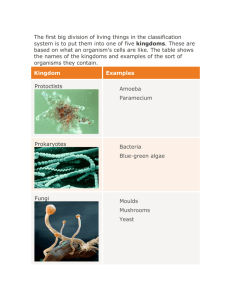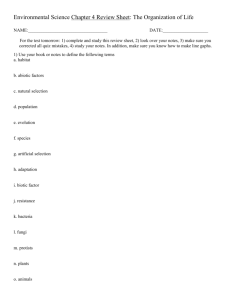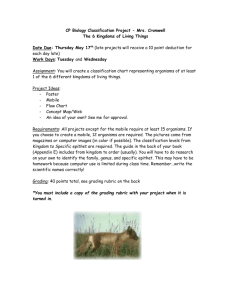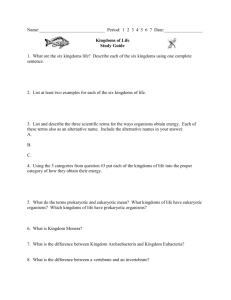kingdoms of living thing project
advertisement
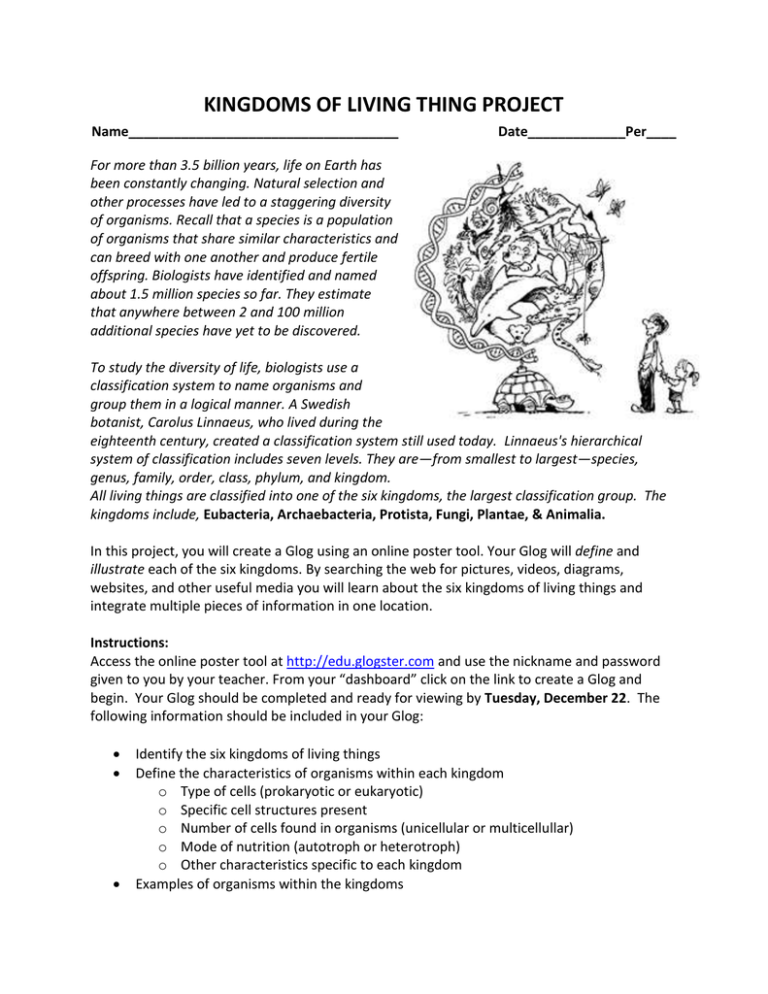
KINGDOMS OF LIVING THING PROJECT Name____________________________________ Date_____________Per____ For more than 3.5 billion years, life on Earth has been constantly changing. Natural selection and other processes have led to a staggering diversity of organisms. Recall that a species is a population of organisms that share similar characteristics and can breed with one another and produce fertile offspring. Biologists have identified and named about 1.5 million species so far. They estimate that anywhere between 2 and 100 million additional species have yet to be discovered. To study the diversity of life, biologists use a classification system to name organisms and group them in a logical manner. A Swedish botanist, Carolus Linnaeus, who lived during the eighteenth century, created a classification system still used today. Linnaeus's hierarchical system of classification includes seven levels. They are—from smallest to largest—species, genus, family, order, class, phylum, and kingdom. All living things are classified into one of the six kingdoms, the largest classification group. The kingdoms include, Eubacteria, Archaebacteria, Protista, Fungi, Plantae, & Animalia. In this project, you will create a Glog using an online poster tool. Your Glog will define and illustrate each of the six kingdoms. By searching the web for pictures, videos, diagrams, websites, and other useful media you will learn about the six kingdoms of living things and integrate multiple pieces of information in one location. Instructions: Access the online poster tool at http://edu.glogster.com and use the nickname and password given to you by your teacher. From your “dashboard” click on the link to create a Glog and begin. Your Glog should be completed and ready for viewing by Tuesday, December 22. The following information should be included in your Glog: Identify the six kingdoms of living things Define the characteristics of organisms within each kingdom o Type of cells (prokaryotic or eukaryotic) o Specific cell structures present o Number of cells found in organisms (unicellular or multicellullar) o Mode of nutrition (autotroph or heterotroph) o Other characteristics specific to each kingdom Examples of organisms within the kingdoms Possible Resources: The following internet pages might be helpful in getting you started. This is not an inclusive list of the information available on the WWW for the six kingdoms of living things. Prentice Hall Biology - Chapter 18 Prentice Hall Biology – Appendix E Classification of Living Things http://www.windows.ucar.edu/tour/link=/earth/Life/classification_intro.html History of Life Through Time - http://www.ucmp.berkeley.edu/exhibits/historyoflife.php The Diversity of Life - http://myweb.cwpost.liu.edu/vdivener/notes/divers_life.htm The Six Kingdoms - http://www.terrebonneonline.com/6kingdoms.htm Tree of Life - http://tolweb.org/tree/phylogeny.html Grading: To earn full credit, the following items should be present in your Glog: Identify the SIX kingdoms of living things (6 points) Characteristics of living things within each kingdom (30 points) Examples of organisms within each kingdom (12 points) Creativity, neatness, grammatically correct (10 points) Completed on time – DECEMBER 22 (2 points)


